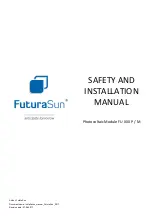
5
FuturaSun srl – The specifications in this manual are subject to revisions without further notice
7. Installation
7a) Module Mounting
•
The FU modules are qualified for an operative
temperature within the range of -40 to +85 °C.
•
The FU modules can be installed at a
maximum operating altitude of ≤ 7000 meters.
•
When installing FU modules, local building
code requirements and regulations must be
adhered to at all times. Sufficient ventilation of
the module backside is required and the
mounting
configuration
(e.g.
sufficient
clearance) should be adapted accordingly
.
•
Do not drill any additional holes into the
module frames and do not cover the
drainage holes
.
•
Pre-assembled mounting systems have
been confirmed by FUTURASUN in writing
in advance
•
The modules can be mounted in every angle
from
horizontal
to
vertical,
avoiding
configurations with the junction box up-side
down at all times (e.g. trackers with “sleep
mode”).
•
In order to maximize module exposure to direct
sunlight, the modules should be oriented to the
south in the northern hemisphere and to the
north in the southern hemisphere.
Mounting Methods:
Mounting using mounting holes:
•
Each module must be securely fastened at
a minimum of 4 points.
•
Use the 4 mounting holes (slots, see Fig. 4)
on the PV module frame to bolt the module
with stainless steel screws and nuts to the
mounting framework.
•
The distance of the mounting holes has
been designed in order to result in a
uniform wind and snow load without
damaging the module.
•
Do not drill additional holes in the module
frame; doing so will void the warranty.
Mounting using clamping method:
•
FUTURASUN recommends the use of
clamps.
•
When using clamps, it is possible to mount
the modules in horizontal (the shorter side
of one module facing the shorter side of the
neighboring module) or in vertical (the
longer
sides
facing
each
other)
configuration. (It is recommended to
always use stainless steel screws and
bolts.)
•
The modules can be mounted on
continuous base structures (inclined or
horizontal) such as rails or similar.
•
Both base structures must be mounted at
the same distance from the symmetrical
axis (vertical or horizontal) of the module.
•
In vertical configuration, it is strongly
recommended to place the supporting
elements nearby the mounting holes, or in
any case, the distances shown in Fig. 3
should be respected. This is necessary in
order to maintain a correct load distribution.
•
The FU XXX P modules with both 60 and
72 cells are qualified to 3600 Pascal x 1,5
safety factor in wind and snow load when
the module is fixed in the green and yellow
area (See Fig. 3)
•
The FU XXX M modules of size 72 cells are
qualified to 1600 Pascal x 1,5 safety factor
in wind and snow load when the module is
fixed in the green and yellow area (See Fig.
3)
•
The FU XXX M modules of size 60 cells are
qualified to 3600 Pascal x 1,5 safety factor
in wind and snow load when the module is
fixed in the green and yellow area (See Fig.
3)
•
In according with Eurocodes - EN 1991 it is
not possible to fix the modules in yellow
area (See Fig. 3) in Zone 3,4,5 of Alpine
Region. Shape coefficients must be taken
into account.
•
In horizontal configuration, fixing the
modules by blocking them at the 4
mounting holes will guarantee the
characteristics regarding the static loads as
certified.
•
When clamping the modules in horizontal
configuration on a support structure, the
distances in Fig. 3 have to be applied in
order to maintain the resistance against
static loads as certified:
•
The modules can also be fixed by placing
them with their frame on a structure that is
supporting the two sides of the frame over
their whole length. Also in this case, the
position of the mounting clamps must be in
accordance with distances indicated in Fig.
3.
•
At least 20 mm spacing must be maintain
between modules
ATTENTION
: in the case of installation with
modules in the vertical position, it is preferable to
maintain the Junction Box located in the upper part
of the module. This practice will help reduce, as
much as possible, contact between any standing
water and the Junction Box, and avoid possible
water infiltration.





























